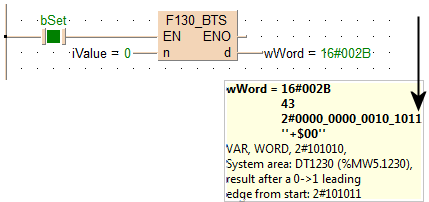


 F130_BTS
F130_BTSImposta bit di un dato a 16 bit
Imposta su TRUE il bit specificato dalla posizione bit in n del dato a 16 bit specificato da d se il trigger EN è in stato TRUE. I bit diversi dal bit specificato non cambiano. L'intervallo di n va da 0 a 15.

Ingresso
area a 16 bit
Uscita
Specifica la posizione bit da impostare

Tutte le variabili di ingresso e uscita utilizzate per programmare questa funzione sono state dichiarate nell'intestazione del POU. La stessa intestazione del POU è utilizzata per tutti i linguaggi di programmazione.

VAR
bSet: BOOL:=FALSE;
(*activates the function*)
iValue: INT:=0;
(*bit position*)
wWord: WORD:=2#101010;
(*result after a 0->1 leading
edge from start: 2#101011*)
END_VARQuando la variabile bSet è impostata su TRUE, la funzione viene eseguita. Il bit alla posizione 0 viene impostato su 1.


BODY
WORKSPACE
NETWORK_LIST_TYPE := NWTYPELD ;
ACTIVE_NETWORK := 0 ;
END_WORKSPACE
NET_WORK
NETWORK_TYPE := NWTYPELD ;
NETWORK_LABEL := ;
NETWORK_TITLE := ;
NETWORK_HEIGHT := 5 ;
NETWORK_BODY
B(B_CONTACT,,bSet,3,1,5,3,);
B(B_VARIN,,iValue,8,2,10,4,);
B(B_VAROUT,,wWord,16,2,18,4,);
B(B_F,F130_BTS!,,10,0,16,4,,?DEN?Dn?AENO?Cd);
L(5,2,10,2);
L(1,2,3,2);
L(1,0,1,5);
END_NETWORK_BODY
END_NET_WORK
END_BODY
IF bSet then
F130_BTS( n:= iValue,
d=> wWord);
END_IF;LD |
start |
(* EN = start; Starting signal for the F130_BTS function. *) |
F130_BTS |
output_value, |
(* n = output_value *) |
0 |
(* d = bit number, here 0 *) |
|
ST |
out |
(* optional *) |